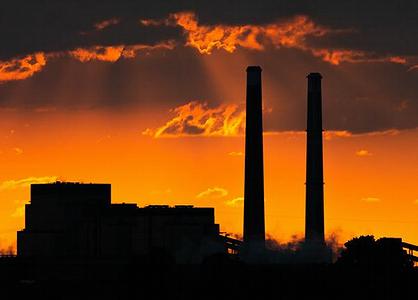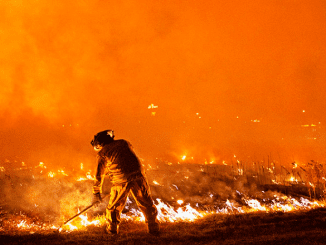
GENEVA, Switzerland, September 10, 2020 (ENS) – Already at their highest levels in three million years, greenhouse gas concentrations in the atmosphere continue to increase, lockdowns around the world to slow the spread of the pandemic coronavirus have forced vehicles to stay parked, making way for clearer skies – temporarily.

But climate change has not stopped for COVID-19. Emissions are heading in the direction of pre-pandemic levels following a temporary decline caused by the lockdown and economic slowdown.
In 2020, emissions of the greenhouse gas carbon dioxide (CO2) are projected to fall by an estimated four to seven percent due to COVID-19 confinement policies. The exact drop in atmospheric CO2 will depend on the trajectory of the pandemic and government responses to address it.
These facts are contained in a new multi-agency report from the world’s largest and most respected scientific organizations, “United in Science 2020.”
The report, the second in a series, was coordinated by the World Meteorological Organization, WMO, with input from the Global Carbon Project, the Intergovernmental Panel on Climate Change, the Intergovernmental Oceanographic Commission of UNESCO, the UN Environment Programme and the UK Met Office.
WMO Secretary-General Professor Petteri Taalas warned, “Greenhouse gas concentrations – which are already at their highest levels in three million years – have continued to rise. Meanwhile, large swathes of Siberia have seen a prolonged and remarkable heatwave during the first half of 2020, which would have been very unlikely without anthropogenic climate change. And now 2016–2020 is set to be the warmest five-year period on record.

“This report shows that whilst many aspects of our lives have been disrupted in 2020, climate change has continued unabated,” Taalas said.
“Major impacts have been caused by extreme weather and climate events. A clear fingerprint of human-induced climate change has been identified on many of these extreme events,” the WMO and UN Met Office say in the report.
Drought and heatwaves substantially increased the risk of wildfires. The three largest economic losses on record from wildfires have all occurred in the last four years. Summer 2019 and 2020 saw unprecedented wildfires in the Arctic region. In June 2019, these fires emitted 50 million tonnes of CO2 into the atmosphere and caused the loss of permafrost. In 2019 and 2020 there were also widespread fires in the Amazon rainforest, with dramatic environmental impacts.
The results of a recent study by World Weather Attribution cited in “United in Science 2020” showed with high confidence that the January to June 2020 heat is at least 600 times more likely as a result of human-induced climate change.
The warming trend documented in this report is likely to continue, and the world is not on track to meet targets set in the 2015 Paris Agreement on climate to keep the global temperature increase well below 2°C or at 1.5°C above pre-industrial levels.
“United in Science 2020” presents the latest scientific data and findings related to climate change to inform global policy and action. It highlights the increasing and irreversible impacts of climate change, which affects glaciers, oceans, nature, economies and human living conditions and is often felt through water-related hazards such as drought or flooding.
It also documents how COVID-19 has impeded our ability to monitor these changes through the global observing system.
“This has been an unprecedented year for people and planet. The COVID-19 pandemic has disrupted lives worldwide. At the same time, the heating of our planet and climate disruption has continued apace,” said UN Secretary-General António Guterres in a foreword to the report.
“Never before has it been so clear that we need long-term, inclusive, clean transitions to tackle the climate crisis and achieve sustainable development. We must turn the recovery from the pandemic into a real opportunity to build a better future,” said Guterres, who presented the report to the UN on Wednesday. “We need science, solidarity and solutions.”
KEY FINDINGS FROM “UNITED IN SCIENCE 2020”
Greenhouse Gas Concentrations in the Atmosphere (World Meteorological Organization)
Atmospheric CO2 concentrations showed no signs of peaking and have continued to increase to new records.

Benchmark stations in the WMO Global Atmosphere Watch network reported CO2 concentrations above 410 parts per million (ppm) during the first half of 2020, with observations from Mauna Loa, Hawaii and Cape Grim, Tasmania at 414.38 ppm and 410.04 ppm, respectively, in July 2020, up about three parts per million from July 2019.
Reductions in emissions of CO2 in 2020 will only slightly impact the rate of increase in the atmospheric concentrations, which are the result of past and current emissions, as well as the very long lifetime of CO2.
“Sustained reductions in emissions to net zero are necessary to stabilize climate change,” the WMO states in its report.
Global Fossil CO2 emissions (Global Carbon Project)
CO2 emissions in 2020 will fall by an estimated four percent to seven percent due to COVID-19 confinement policies. The exact percent of decline will depend on the trajectory of the pandemic and government responses to address it.
During peak lockdown in early April 2020, the daily global fossil CO2 emissions dropped by an unprecedented 17 percent compared to 2019.
But even so, emissions were still equivalent to 2006 levels, highlighting both the steep growth over the past 15 years and the continued dependence on fossil sources for energy.
By early June 2020, global daily fossil CO2 emissions had mostly returned to within five percent below 2019 levels, which reached a new record of 36.7 gigatonnes last year, 62 percent higher than at the start of climate change negotiations in 1990.
Global methane emissions from human activities, too, have continued to increase over the past decade. “Current emissions of both CO2 and methane are not compatible with emissions pathways consistent with the targets of the Paris Agreement,” the report warns.
Emissions Gap (UN Environment Programme)

“Transformational action can no longer be postponed if the Paris Agreement targets are to be met,” urges the UN Environment Programme.
The UNEP Emissions Gap Report 2019 showed that the cuts in global emissions required per year from 2020 to 2030 are close to three percent for a 2°C target and more than seven percent per year on average for the 1.5°C goal of the Paris Agreement.
The Emissions Gap in 2030 is estimated at 12-15 gigatonnes (Gt) of carbon dioxide equivalent (CO2e) to limit global warming to below 2°C. For the 1.5°C goal, the gap is estimated at 29-32 Gt CO2e, roughly equivalent to the combined emissions of the six largest-emitting countries.
“It is still possible to bridge the emissions gap, but this will require urgent and concerted action by all countries and across all sectors,” UNEP said.
“A substantial part of the short-term potential can be realized through scaling up existing, well-proven policies, for instance on renewables and energy efficiency, low carbon transportation means and a phase-out of coal,” the UN agency said.
Technically and economically feasible solutions already exist, said UNEP. Looking beyond the 2030 timeframe, new technological solutions and gradual change in consumption patterns are needed at all levels.
State of Global Climate (WMO and UK’s Met Office)
The average global temperature for 2016–2020 is expected to be the warmest on record, about 1.1°C above 1850-1900, a reference period for temperature change since pre-industrial times and 0.24°C warmer than the global average temperature for 2011-2015.
In the five-year period 2020–2024, the chance of at least one year exceeding 1.5°C above pre-industrial levels is 24 percent, with a very small chance (three percent) of the five-year mean exceeding this level. “It is likely (~70 percent chance) that one or more months during the next five years will be at least 1.5 °C warmer than pre-industrial levels,” the two agencies said in the report.
In every year between 2016 and 2020, the Arctic sea ice extent has been below average.
The years 2016–2019 recorded a greater glacier mass loss than all other past five-year periods since 1950.
The rate of global mean sea-level rise increased between the five-year periods 2011–2015 and 2016–2020.
The Ocean and Cryosphere in a Changing Climate (Intergovernmental Panel on Climate Change)
Human-induced climate change is affecting life-sustaining systems, from the top of the mountains to the depths of the oceans, leading to accelerating sea-level rise, with cascading effects for ecosystems and human security.

This increasingly challenges adaptation and integrated risk management responses.
Ice sheets and glaciers worldwide have lost mass. Between 1979 and 2018, Arctic sea-ice extent has decreased for all months of the year. Increasing wildfire and abrupt permafrost thaw, as well as changes in Arctic and mountain hydrology, have altered the frequency and intensity of ecosystem disturbances.
The global ocean has warmed unabated since 1970 and has taken up more than 90 percent of the excess heat in the climate system. Since 1993 the rate of ocean warming, and thus heat uptake has more than doubled.
Marine heatwaves have doubled in frequency and have become longer-lasting, more intense and more extensive, resulting in large-scale coral bleaching events. The ocean has absorbed between 20 percent to 30 percent of total anthropogenic CO2 emissions since the 1980s causing further ocean acidification.
Since about 1950 many marine species have undergone shifts in geographical range and seasonal activities in response to ocean warming, sea-ice change and oxygen loss.
The global mean sea-level is rising, with acceleration in recent decades due to increasing rates of ice loss from the Greenland and Antarctic ice sheets, as well as continued glacier mass loss and ocean thermal expansion. The rate of global mean sea-level rise for 2006–2015 of 3.6 ±0.5 mm/yr is unprecedented over the last century
Climate and Water Resources (WMO)
Climate change impacts are most felt through changing hydrological conditions including changes in snow and ice dynamics.
By 2050, the number of people at risk of floods will increase from its current level of 1.2 billion to 1.6 billion. In the early to mid-2010s, 1.9 billion people, or 27 percent of the global population, lived in potentially water-scarce areas. In 2050, this number will increase to 2.7 to 3.2 billion people.
As of 2019, 12 percent of the world population drinks water from unimproved and unsafe sources. More than 30 percent of the world population, or 2.4 billion people, live without any form of sanitation.
Climate change is projected to increase the number of water-stressed regions and exacerbate shortages in already water-stressed regions.
The cryosphere is an important source of freshwater in mountains and their downstream regions. There is high confidence that annual runoff from glaciers will reach peak globally at the latest by the end of the 21st century. After that, glacier runoff is projected to decline globally with implications for water storage.
It is estimated that Central Europe and Caucasus have reached peak water now and that the Tibetan Plateau region will reach peak water between 2030 and 2050. As runoff from snow cover, permafrost and glaciers in this region provides up to 45 percent of the total river flow, the flow decrease would affect water availability for 1.7 billion people.
Earth System Observations during COVID-19 (Intergovernmental Oceanographic Commission of UNESCO and WMO)
The COVID-19 pandemic has produced significant impacts on the global observing systems, which in turn have affected the quality of forecasts and other weather, climate and ocean-related services.
The reduction of aircraft-based observations by an average of 75 percent to 80 percent in March and April degraded the forecast skills of weather models. Since June, there has been only a slight recovery. Observations at manually operated weather stations, especially in Africa and South America, have also been badly disrupted.
For hydrological observations like river discharge, the situation is similar to that of atmospheric in situ measurements. Automated systems continue to deliver data whereas gauging stations that depend on manual reading are affected.
In March 2020, nearly all oceanographic research vessels were recalled to home ports. Commercial ships have been unable to contribute vital ocean and weather observations, and ocean buoys and other systems could not be maintained. Four full-depth ocean surveys of variables such as carbon, temperature, salinity, and water alkalinity, completed only once per decade, have been canceled. Surface carbon measurements from ships, which tell us about the evolution of greenhouse gases, also effectively ceased.
The impacts on climate change monitoring are long-term. They are likely to prevent or restrict measurement campaigns for the mass balance of glaciers or the thickness of permafrost, usually conducted at the end of the thawing period. The overall disruption of observations will introduce gaps in the historical time series of Essential Climate Variables needed to monitor climate variability and change and associated impacts.
The report “United in Science 2020” is online at: public.wmo.int/en/resources/united_in_science
Copyright Environment News Service (ENS) 2020. All rights reserved.
© 2020, Environment News Service. All rights reserved. Content may be quoted only with proper attribution and a direct link to the original article. Full reproduction is prohibited.



